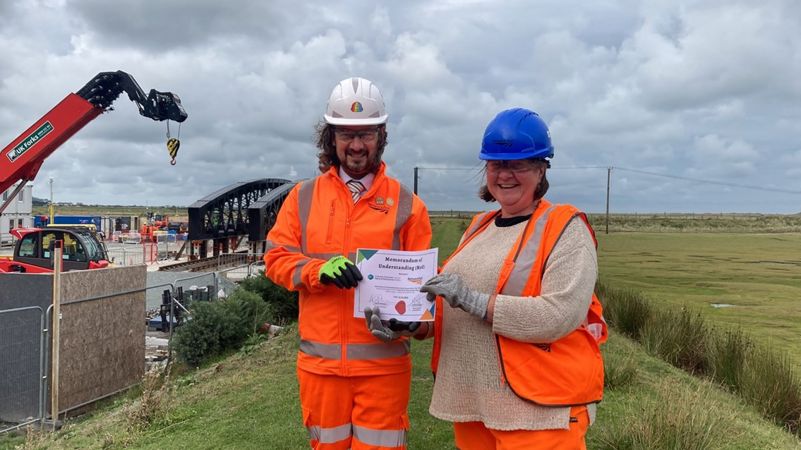Network Rail and Natural Resource Wales’s partnership ‘on track’ to securing a greener future, combating climate change and improving rail links for passengers

The two organisations have solidified their commitment to working more closely together following the renewal of their Memorandum of Understanding (MoU).
The agreement, which is typically renewed every five years, reinforces an exciting partnership towards a common goal: driving environmental sustainability for the benefit of communities, creating a more resilient railway by being better prepared to combat nature and climate emergencies, and promoting responsible practices across the route’s rail infrastructure.
Both organisations have already helped each other on a number of coastal and river schemes to reduce flood risk, protect habitats, manage land, and better plan projects.
An example where this partnership has been extremely effective, and crucially time saving, was the extensive remedial work following the derailment of a freight train at Llangennech, in Carmarthenshire, in August 2020.
More than 30,000 tonnes of fuel-soaked soil was excavated from beneath 150 metres of railway track - preventing lasting environmental impact and protecting the local landscape.
The collaborative way of working, on such a high impact incident, was invaluable and ensured that public funds were used in the most effectual way possible.
Some other significant schemes include:
- Barmouth Viaduct renewal (current) – Network Rail is undertaking a significant renewal to the listed structure over the Mawddach estuary. The two organisations have worked collaboratively to ensure the required works to the viaduct are completed without adversely impacting the delicate ecology of the SSSI Mawddach Estuary.
- Dovey junction Structures renewal (current) – Network Rail is delivering a bridge renewal which spans the Dovey estuary and, working with Natural Resources Wales, has allowed us to find a satisfactory methodology to minimise the impact on what is an ecologically sensitive area.
- Stephenson street (current) - in Newport where Natural Resources Wales is doing work on four culverts under the railway - tying their flood defence bund into the railway embankment.
- Ammanford flood alleviation scheme (current) - where Natural Resources Wales is tying in their flood defence bund with a Network Rail structure.
- Conwy valley resilience scheme (2019) – Network Rail worked closely with Natural Resources Wales who were able to reactively assist in the permitting and applications to build the railway back in a more resilient manner to prevent similar washouts in adverse weather events.
- Black bridge track raising scheme (2018) – Network Rail raised the structure higher in the floodplain which now means the Cambrian line has to close less frequently allowing passengers to complete their journeys in times of heavy rainfall.
Clare Pillman, Chief Executive of Natural Resources Wales, said:
“We are very pleased to be building on the collaborative partnership that already exists with Network Rail by signing this memorandum.
“When organisations work together we can do more. So this agreement means the environment and rail users all benefit.
“The State of Natural Resources Report 2020 emphasised that different organisations need to collaborate to improve the resilience of our environment, particularly as we reimagine the transport system, and this partnership puts this principle into practice.”
Nick Millington, Wales and Border route director at Network Rail said:
“By combining the expertise, knowledge, and resources of our two organisations in this way, we’re able to work in a more time efficient, cost-effective, safe and sustainable way - creating a positive and lasting impact on the environment, whilst improving rail links for passengers.
“The importance of this collaboration has been demonstrated time and time again over the years, and we’re very pleased to be renewing our joint commitment to achieving a more sustainable and ecologically responsible approach to the way we work.”
The aspirations of the memorandum will be supported by an annual intentions plan to drive the collaboration forward.
